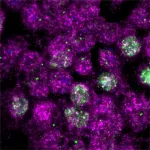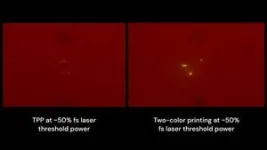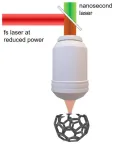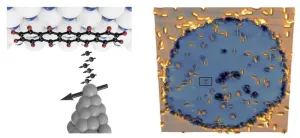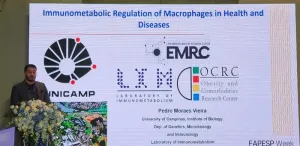(Press-News.org) In a recent study, researchers at Johns Hopkins Medicine suggest the cell’s messenger RNA (mRNA) — the major translator and regulator of genetic material — along with a critical protein called ZAK, spur the cell’s initial response to UV radiation damage and play a critical role in whether the cell lives or dies.
While UV radiation has long been known to damage DNA, it also damages mRNA, and the latest findings, published June 5 in Cell, indicate that mRNAs act as first responders in telling the cells how to manage the stress.
“RNA is a canary in the coal mine. It’s telling the cell, ‘We’ve got major damage here and we need to do something,’” says Rachel Green, Ph.D., a Bloomberg Distinguished Professor of Molecular Biology and Genetics and Daniel Nathans Director of the Department of Molecular Biology and Genetics at the Johns Hopkins University School of Medicine. Green, also an investigator at Howard Hughes Medical Institute, is the corresponding author of the new study.
ZAK is a key player in a process that identifies cellular damage by sensing the collisions of ribosomes, tiny macromolecular machines that help RNA translate the language of genes into the language of proteins. Collisions occur when ribosomes move along UV-damaged mRNAs and, unable to decode the damaged message, cause stalled ribosomes to get “rear-ended” by upstream ribosomes. Ribosome collisions activate ZAK, which triggers a cellular signaling program known as the ribotoxic stress response. ZAK then instigates a cascade of downstream events that decide the cell’s fate.
A more comprehensive understanding of how cellular life-and-death decisions are made upon encountering UV radiation could help investigators understand underlying causes of skin and other cancers, says Niladri Sinha, Ph.D., Jane Coffin Childs Memorial Fund Postdoctoral Fellow at Johns Hopkins School of Medicine. Companies developing drugs that target ribosomes may also find that ZAK could be a driver of cell death across cancer types, he says.
The findings indicate that ZAK senses the extent of cellular damage and responds depending on how much UV radiation the cell receives, offering a more nuanced understanding of UV-caused cell death and identifying new ways to keep ZAK’s activity under control, Green says.
“There are graded ways that ZAK responds, it’s not all or nothing,” she says.
The research also “very clearly shows” that, for example, a skin cell’s fate in the immediate aftermath of UV radiation is “driven primarily by the extent of colliding ribosomes and ZAK signaling,” Green says.
“In this regime, DNA damage and the well-characterized DNA damage response pathway, including the key protein p53, do not significantly determine cell fate decisions,” she says.
DNA damage repair is critical and occurs in a subset of cells that are copying their genetic material, but these pathways are not the major “deciders” of cell fate, she says.
Green co-led the research with Sergi Regot, Ph.D., associate professor of molecular biology and genetics at the Johns Hopkins University School of Medicine, and Alban Ordureau, Ph.D., assistant member of the Cell Biology Program at Memorial Sloan Kettering Cancer Center’s Sloan Kettering Institute and an assistant professor at Weill Cornell.
To conduct their research, the scientists exposed human cellular models to a UV lamp mimicking the sun’s radiation. Using proteomics to understand cell signaling in an approach led by Ordureau, they evaluated ZAK’s role and made predictions about how cells would respond to different levels of stress. From there, live cell imaging experiments led by Regot, in addition to in-house ribosome biochemistry — the workhorse of Green’s laboratory — helped characterize how cellular death is regulated as a consequence of ZAK-mediated UV radiation.
In the future, the researchers plan to investigate cell types with different protein synthesis regimes, including those in melanoma and other cancers. The researchers suspect that fast-growing cells will rely on ZAK-mediated regulation more than others, Green says.
Funding for this research was provided by the Howard Hughes Medical Institute, the National Institutes of Health (NIH 1R35GM133499), a National Science Foundation Career grant, the Jane Coffin Childs Memorial Fund for Medical Research Fellowship, and the National Institute of General Medical Sciences, Sloan Kettering Institute startup funds, Pew Charitable Trusts, a Memorial Sloan Kettering Cancer Center support grant, and the Basic Science Research Program from the National Research Foundation of Korea; Ministry of Education.
Other scientists who contributed to this study are Connor McKenney, Zhong Y. Yeow, and Jeffrey J. Li of Johns Hopkins; Ki Hong Nam of Memorial Sloan Kettering Cancer Center’s Sloan Kettering Institute; and Tomer M. Yaron-Barir, Jared L. Johnson, Emily M. Huntsman and Lewis C. Cantley of Weill Cornell Medicine.
Green is a member of the scientific advisory board of Alltrna, Initial Therapeutics and Arrakis Pharmaceuticals, consults for Vertex Pharmaceuticals, Bristol-Myers Squibb (Celgene), Monta Rosa Therapeutics and Flagship Pioneering, and served on the scientific advisory board at Moderna.
Green, Regot, Sinha and McKenney have filed for a patent related to work described in this research.
DOI: doi.org/10.1016/j.cell.2024.05.018
END
UV radiation damage leads to ribosome roadblocks, causing early skin cell death
Findings alter previous scientific views, and may be relevant to skin cancer development
2024-07-02
ELSE PRESS RELEASES FROM THIS DATE:
Precise and less expensive 3D printing of complex, high-resolution structures
2024-07-02
WASHINGTON — Researchers have developed a new two-photon polymerization technique that uses two lasers to 3D print complex high-resolution structures. The advance could make this 3D printing process less expensive, helping it find wider use in a variety of applications.
Two-photon polymerization is an advanced additive manufacturing technique that traditionally uses femtosecond lasers to polymerize materials in a precise, 3D manner. Although this process works well for making high-resolution microstructures, it isn’t widely used in manufacturing ...
AGS member, George Kuchel, appointed to serve on ACIP
2024-07-02
The American Geriatrics Society extends its warmest congratulations to ADGAP President George Kuchel, MD, CM, FRCP on his appointment as a member expert of the Advisory Committee on Immunization Practices (ACIP). ACIP develops recommendations on the safe use of vaccines in the United States.
Dr. Kuchel, who became President of the Association of Directors of Geriatrics Academic Programs in spring 2024, is Director of both the UConn Center on Aging and the Claude D Pepper Older Americans Independence Center at the University of Connecticut. He has significant expertise and knowledge in vaccines and immunology, particularly in older adults, including performing ...
Researchers awarded Department of Defense grant to study the role of gut microbiomes to improve outcomes in dystonia
2024-07-02
Mohammad Moshahid Khan, PhD, principal investigator and associate professor in the Department of Neurology in the College of Medicine at the University of Tennessee Health Science Center, was recently awarded a $308,000 grant from the Department of Defense for a study that will investigate the role of the gut microbiome in dystonia, a movement disorder of abnormal postures and involuntary twisting or repetitive movements, to improve neurobehavioral outcomes. Jianfeng Xiao, MD, PhD, associate professor in the Department of Neurology, is the co-investigator of the study.
Although ...
Advancing toward a preventative HIV vaccine
2024-07-02
LA JOLLA, CA and NEW YORK, NY—A major challenge in developing a vaccine for HIV is that the virus mutates fast—very fast. Although a person initially becomes infected with one or a few HIV strains, the virus replicates and mutates quickly, resulting in a “swarm” of viral strains existing in a single body. But scientists at Scripps Research; IAVI; the Ragon Institute of Mass General, MIT, and Harvard; La Jolla Institute for Immunology; and additional institutions have conducted a series of preclinical ...
A Global Heat Early Warning system is now essential, and requires planning in four key areas to overcome barriers and enable successful implementation, per new review
2024-07-02
A Global Heat Early Warning system is now essential, and requires planning in four key areas to overcome barriers and enable successful implementation, per new review.
####
Article URL: https://journals.plos.org/climate/article?id=10.1371/journal.pclm.0000437
Article Title: Preventing heat-related deaths: The urgent need for a global early warning system for heat
Author Countries: Austria, Denmark, Sweden, Switzerland, US
Funding: CB,IMO, CG and JT are funded by Horizon Europe through the HIGH horizon project funded by the European Union’s Horizon Europe Programme (grant number 101057843). IMO and CG are also ...
An alternative way to manipulate quantum states
2024-07-02
Electrons have an intrinsic angular momentum, the so-called spin, which means that they can align themselves along a magnetic field, much like a compass needle. In addition to the electric charge of electrons, which determines their behaviour in electronic circuits, their spin is increasingly used for storing and processing data. Already now, one can buy MRAM memory elements (magnetic random access memories), in which information is stored in very small but still classical magnets – that is, ...
Study reveals new factor associated with the risk of severe COVID-19 in people with obesity
2024-07-02
Already at the beginning of the COVID-19 pandemic, a group of Brazilian researchers pioneered in showing why SARS-CoV-2 infection tends to be more severe in diabetic patients. Now, the same team based at the Institute of Biology of the State University of Campinas (IB-UNICAMP) has discovered one of the reasons why obese people who do not have diabetes or even insulin resistance also have an increased risk of developing the severe form of the disease.
“New experiments show that the molecular mechanisms are quite different in the two cases,” Pedro Moraes-Vieira, a professor at IB-UNICAMP, who is coordinating ...
Study finds that influential people can play a valuable role in getting people to act in the best interest of society
2024-07-02
Getting individuals to act in the best interest of society can be a tricky balancing act, one that often walks a fine line between trying to convince people to act of their own volition, versus passing laws and regulations that make these actions compulsory.
In a new paper, published in the journal PNAS Nexus, SFI External Professor Stefani Crabtree (Utah State University) and Science Board Fellow Simon Levin (Princeton University), together with Colin Wren (University of Colorado, Colorado Springs) and Avinash ...
Editorial: Genomics has more to reveal
2024-07-02
“If there was any doubt, this discovery demonstrates that genomics, extensively deployed over the past two decades, still has much to reveal to us.”
BUFFALO, NY- July 2, 2024 – A new editorial paper was published in Oncotarget's Volume 15 on June 20, 2024, entitled, “Genomics has more to reveal.”
In this new editorial, researchers Laurène Fenwarth and Nicolas Duployez from the University of Lille and CHU Lille discuss molecular and cytogenetic analyses that are now used to identify mutations and structural variants defining distinct subtypes of acute myeloid leukemias (AML) ...
COVID-19 pandemic tied to low birth weight for infants in India, study shows
2024-07-02
The incidence of low birth weight rose sharply in India amid the COVID-19 pandemic, according to new research from the University of Notre Dame.
Globally, 1 in 4 newborns has a low birth weight (less than 5.5 pounds), and the problem disproportionately affects low- and middle-income countries — particularly in South Asia, home to approximately one-fourth of the world’s population.
Santosh Kumar, associate professor of development and global health economics at Notre Dame’s Keough School of Global Affairs, co-authored the study published in Communications Medicine, a Nature series journal.
“This research shows that low birth weight became more common in India ...
LAST 30 PRESS RELEASES:
Study showcases resilience and rapid growth of “living rocks”
Naval Research Lab diver earns Office of Naval Research 2025 Sailor of the Year
New Mayo-led study establishes practical definition for rapidly progressive dementia
Fossil fuel industry’s “climate false solutions” reinforce its power and aggravate environmental injustice
Researchers reveal bias in a widely used measure of algorithm performance
Alcohol causes cancer. A study from IOCB Prague confirms damage to DNA and shows how cells defend against it
Hidden viruses in wastewater treatment may shape public health risks, study finds
Unlock the power of nature: how biomass can transform climate mitigation
Biochar reshapes hidden soil microbes that capture carbon dioxide in farmland
Reducing saturated fat intake shows mortality benefit, but only in high-risk individuals
Manta rays create mobile ecosystems, study finds
Study: Mixed results in using lipoic acid to treat progressive multiple sclerosis
Norbert Holtkamp appointed director of Fermi National Accelerator Laboratory
New agentic AI platform accelerates advanced optics design
Biologists discover neurons use physical signals — not electricity — to stabilize communication
Researchers discover that a hormone can access the brain by hitchhiking
University of Oklahoma researcher awarded funding to pursue AI-powered material design
Exploring how the visual system recovers following injury
Support for parents with infants at pediatric check-ups leads to better reading and math skills in elementary school
Kids’ behavioral health is a growing share of family health costs
Day & night: Cancer disrupts the brain’s natural rhythm
COVID-19 vaccination significantly reduces risk to pregnant women and baby
The role of vaccination in maternal and perinatal outcomes associated with COVID-19 in pregnancy
Mayo Clinic smartwatch system helps parents shorten and defuse children's severe tantrums early
Behavioral health spending spikes to 40% of all children’s health expenditures, nearly doubling in a decade
Digital cognitive behavioral treatment for generalized anxiety disorder
Expenditures for pediatric behavioral health care over time and estimated family financial burden
Air conditioning in nursing homes and mortality during extreme heat
The Alps to lose a record number of glaciers in the next decade
What makes a good proton conductor?
[Press-News.org] UV radiation damage leads to ribosome roadblocks, causing early skin cell deathFindings alter previous scientific views, and may be relevant to skin cancer development
